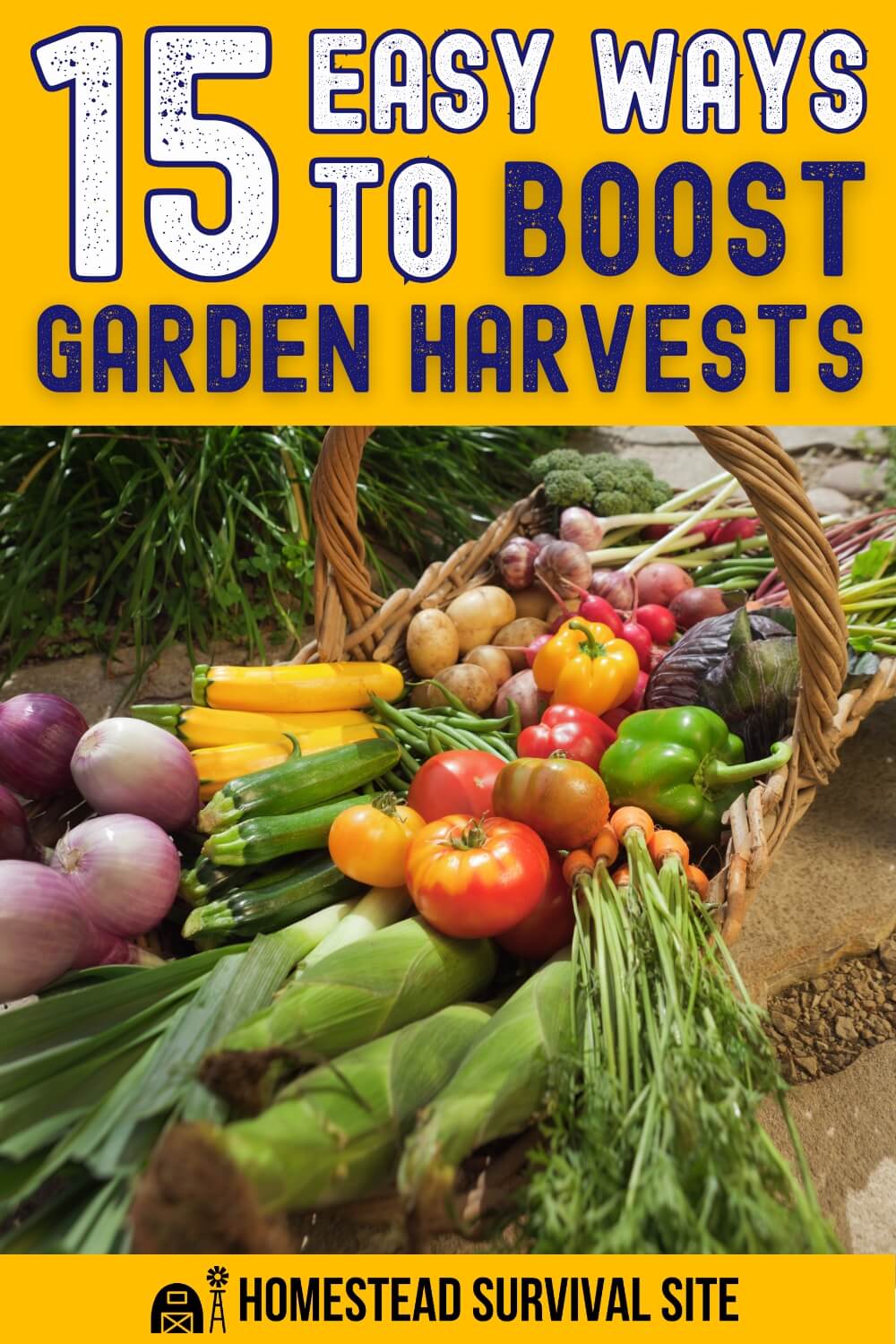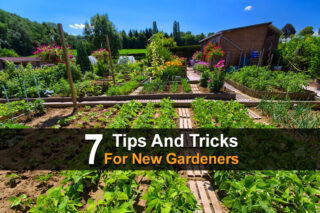Estimated reading time: 7 minutes
There's nothing quite like the satisfaction of growing your own food. Not only does home-grown produce taste great, but you are in control of what fertilizers and pesticides come into contact with your garden.
Whether you are a new or a seasoned garden, you may be looking for ways to increase your yield this year. If you have space for cultivating more beds, that's one way. However, even if you have limited space, here are 15 strategies to boost your harvest.
Want to save this post for later? Click Here to Pin It On Pinterest!
1. Select High-Yield Plants
Some plants, and some varieties within a category, just naturally produce more than other plants. For example, in the space required by one cauliflower plant, you could grow nearly a dozen pole or bush bean plants.
By choosing from the following high-yield plants, you can get a bigger harvest with the same amount of work.
- Beans – Especially pole beans, which keep producing as long as you keep picking.
- Carrots – Great for dense planting and perfect for successive harvests.
- Collard Greens – Tough and generous with leaves that keep on coming.
- Cucumbers – Vining types are super prolific and can be trained to grow vertically.
- Eggplant – A heavy producer in warm climates with regular harvesting.
- Kale – Cold-hardy and keeps producing if you harvest the outer leaves.
- Okra – Thrives in heat and just keeps putting out pods.
- Peas – Sweet, crunchy, and one of the first to hit your harvest basket.
- Potatoes – Excellent return on investment when planted in good soil or containers.
- Radishes – Fast growers you can keep reseeding for a steady crop.
- Spinach – Ideal for cut-and-come-again harvesting in cooler months.
- Squash – Especially summer squash, which can go wild once it gets going.
- Swiss Chard – Colorful, resilient, and provides leaves all season long.
- Tomatoes (especially cherry tomatoes) – One plant can yield dozens of fruits.
- Turnips – A two-for-one deal with edible greens and tasty roots.
- Zucchini – The classic overachiever that just doesn’t quit.
Once they are established well, apples, raspberries, and other berries produce heavy crops.
2. Extend Your Growing Season
You can start early and end late by starting seedlings indoors in late winter or early spring and bringing them undercover in the fall.
Use grow lights indoors to start plants and season-stretching devices such as cold frames, cloches, row covers, and tunnels to protect fall crops from early frost.
More Info: The Ultimate Guide to Starting Seeds
3. Try Staggered Spacing
You don't need to plant in straight, parallel rows. You can stagger them throughout the beds for more efficient use of your garden space. A technique known as block planting allows you to take advantage of spaces, such as the corners, that are often wasted in row planting. This method works well in small spaces and when you are using raised beds or blocks of concrete, wood, or bricks to create a border.
Also, make sure you are not wasting space by planting your veggies too far apart. Check the instructions on your seed packets or plant tags carefully. Use a ruler to ensure you are giving plants enough room to grow, but not too much. Another way to maximize planting space is to minimize the walkway space around your beds.
4. Practice Interplanting
Another way to get more out of your garden is with interplanting. With this strategy, you plant two crops in the same area by mixing slow- and fast-growing vegetables. You can harvest the quick-growing vegetables – like radishes or lettuce, for example – before the slower-growing ones (like parsnips or corn) need the extra space.
More Info: A Simple Guide to Companion Planting
5. Sow A Succession Crop
With succession planting, you use the same garden space for more than one plant. After you harvest the early cold-weather crop (like some lettuces), you plant a heat-loving summer plant (like tomatoes). Then, you can grow plants that will be ready to harvest in early fall (like bush beans or kale). Be sure to nourish the soil with compost between your crops.
More Info: Succession Planting: The Secret to Doubling Your Harvest
6. Grow Up
Gardening does not have to just go in a horizontal direction. You can maximize your space and increase your yield with vertical gardening. Any plant with a vining nature can be trained to grow upward with the help of a stake, cage, trellis, or a fence.
Strawberries, cucumbers, vining tomatoes, climbing peas and beans, and sprawling squashes are a few examples. Despite what you think, even heavy fruits, such as melons, can produce well when they grow vertically. When they are trained to grow up, they develop thicker stems to handle the weight.
Another advantage of vertical gardening is that these plants are less susceptible to fungal disease.
More info: Vertical Gardening: A Great Option for Urban Preppers
7. Use More Than The Ground
Another way to boost your harvest is to grow plants in new places. Many varieties of fruits and vegetables do well in containers on your deck or balcony. You can grow herbs in your windowsills and strawberries in hanging baskets.
More Info: 10 Container Ideas for Your Garden
8. Make Room For Flowers
Flowers in a vegetable bed? Yes, indeed. Not only do they look pretty, but they attract pollinating bees. And don't forget that many flowers — including nasturtiums, calendula, and bee balm — are edible.
More Info: 10 Flowers You Need In Your Vegetable Garden
9. Use Rainwater To Irrigate Your Garden
Rainwater is softer and has more nutrients and fewer chemicals than city water. Collect rainwater from your roof and use it to water your fruits and vegetables.
No matter what type of water you use, it's essential to irrigate consistently. If your tomatoes tend to form cracks, it may be due to inconsistent watering. Consider soaker hoses on timers to water plants at ground level on a regular basis.
More Info: 7 Rainwater Collection Systems
10. Stay On Top Of Weeds
How does better weeding increase your yield? It's simple – weeds compete with your fruits and vegetable plants for water and soil nutrients. Be consistent in pulling weeds that invade your beds.
More Info: 15 Ways to Kill Weeds Naturally
11. Nourish Your Plants
Fertilizer goes a long way in helping your plants produce a higher yield. It also helps them grow strong enough to fend off disease and pests.
More Info: How to Make Homemade Fertilizers
12. Monitor And Manage Pests
Speaking of pests and disease, keep a close eye on your pets to nip any potential problems in the bud. Some pests do mostly cosmetic damage, and others can devastate your entire crop. Consult with your local University Extension Office for tips on pest and disease management in your area.
More Info: 11 All-Natural Ways to Keep Pests Out of Your Garden
13. Harvest When The Fruit Is Young
When you pick young fruit, it encourages the plant to produce more fruit. Yes, the fruit may continue to grow, but it usually tastes better when it's young. And you'll get a higher overall yield.
14. Rotate Your Crops
Planting the same crops in the same spot year after year can deplete specific nutrients in the soil and lead to pest and disease buildup. A simple crop rotation system helps break pest cycles and keeps your soil balanced and healthy.
Try rotating plant families — for example, follow tomatoes (nightshades) with beans (legumes), which help fix nitrogen in the soil. Your plants will thank you with a bigger, healthier harvest.
More Info: The Complete Guide to Crop Rotation
15. Mulch Like a Pro
Mulch isn’t just for keeping weeds down — it also conserves moisture, regulates soil temperature, and boosts overall plant health. Organic mulches like straw, shredded leaves, or grass clippings break down over time and improve your soil.
Apply a thick layer around your plants, leaving a bit of space around the stem, and you’ll see the benefits in fewer weeds, less watering, and stronger crops.
More Info: The Ultimate Guide to Mulching
Like this post? Don't Forget to Pin It On Pinterest!
You May Also Like:












